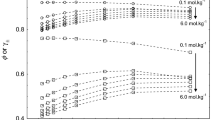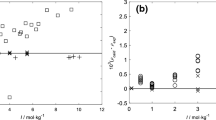Abstract
A flow microcalorimeter/densimeter system has been commissioned to measure heat capacities and densities of solutions containing radioactive species as a function of temperature. Measurements were made for NaTcO4(aq) at six temperatures (189.15 K to 373.15 K for the heat capacities, 287.43 K to 396.67 K for the densities) over the molality range 0.01 to 0.29 mol-kg−1. Measurements for NaReO4(aq) (NaReO4 is a common nonradioactive analogue for NaTcO4) were made under similar conditions, but for eight temperatures and a more extensive range of molalities, 0.05 to 0.65 mol-kg−1. Heat capacities of NaCl(aq) reference solutions were also measured from 293.15 K to 398.15 K.
The heat capacity and density data are analysed using Pitzer's ioninteraction model. Equations for the apparent molar heat capacities and volumes are reported. Values of the NaReO4(aq) partial molar heat capacities are compared to literature values based on integral heats of solution. The agreement between the two sets of NaReO4 results is good below 330 K, but only fair at the higher temperatures. Values of the partial molar volumes have also been derived. Using literature values and the results of our experiments, it is calculated that the disproportionation of hydrated TcO2(s) to form TcO −4 (aq) and Tc(cr) occurs more readily at high temperatures. The uncertainties introduced by using thermodynamic values for ReO −4 (aq), in the absence of values for TcO −4 (aq), are discussed.
Similar content being viewed by others
References
L. J. Clegg and J. R. Coady,Radioactive Decay Properties of CANDU Fuel. Volume 1: The Natural Uranium Cycle, Atomic Energy of Canada Limited Report AECL-4436/1, 1977.
J. A. Rard,Critical Review of the Chemistry and Thermodynamics of Technetium and some of its Inorganic Compounds and Aqueous Species, Lawrence Livermore National Laboratory Report UCRL-53440, 1983.
K. S. Pitzer,J. Phys. Chem. 77, 268 (1973).
L. F. Silvester and K. S. Pitzer,J. Phys. Chem. 81, 1822 (1977).
J. C. Ahluwalia and J. W. Cobble,J. Amer. Chem. Soc. 86, 5377 (1964).
P. P. S. Saluja, J. C. LeBlanc, and H. B. Hume,Can. J. Chem. 64, 926 (1986).
P. P. S. Saluja and J. C. LeBlanc,J. Chem. Eng. Data 32, 72 (1987).
P. P. S. Saluja, R. J. Lemire, and J. C. LeBlanc,J. Chem. Thermodyn. 24, 181 (1992).
R. H. Busey, R. B. Bevan, Jr., and R. A. gilbert,J. Chem. Thermodyn. 4, 77 (1972).
L. Haar, G. S. Gallagher, and G. S. Kell, 1983.NBS/NRC Steam Tables, (Hemisphere Publishing, Washington, 1983).
J. E. Desnoyers, C. de Visser, G. Perron, and P. Picker,J. Solution Chem. 5, 605 (1976).
D. E. White and R. H. Wood,J. Solution Chem. 11, 223 (1982).
P. S. Z. Rogers and C. J. Duffy,J. Chem. Thermodyn. 21, 595 (1989).
J.-L. Fortier, P.-A. Leduc, and J. E. Desnoyers,J. Solution Chem. 3, 323 (1974).
J. E. Tanner and F. W. Lamb,J. Solution Chem. 7, 303 (1978).
K. S. Pitzer, J. C. Peiper, and R. H. Busey,J. Phys. Chem. Ref. Data 13, 1 (1984).
R. T. Pabalan and K.S. Pitzer,Geochim. Cosmochim. Acta 51, 2429 (1987).
P. S. Z. Rogers and K.S. Pitzer,J. Phys. Chem. Ref. Data 11, 15 (1982).
P. P. S. Saluja, K. S. Pitzer, and R. C. Phutela,Can. J. Chem. 64, 1328 (1986).
R. C. Phutela, K. S. Pitzer, and P. P. S. Saluja,J. Chem. Eng. Data 32, 76 (1987).
D. J. Bradley and K.S. Pitzer,J. Phys. Chem. 83, 1599 (1979).
J. R. Maurey, and J. Wolff,J. Inorg. Nucl. Chem. 25, 312 (1963).
V. Neck and B. Kanellakopulos,Radiochim. Acta 42, 135 (1987).
R. J. Lemire and F. Garisto,The Solubility of U, Np, Pu, Th and Tc in a Geological Disposal Vault for Used Nuclear Fuel, Atomic Energy of Canada Limited Report AECL-10009, 1989.
W. M. Latimer, 1952.Oxidation potentials (Prentice-Hall, Englewood Cliffs, 1952).
G. B. Naumov, B. N. Ryzhenko, and I. L., Khodakovsky, 1971.,Handbook of Thermodynamic Data, (English edn.) translator, G. J. Soleimani; I. Barnes and V. Spelz, eds., Report WRD-74-01, U.S. Geological Survey, Menlo Park, CA, 1974.
C.M.Criss and J.W. Cobble,J. Amer. Chem. Soc. 86, 5385 (1964).
C.M.Criss and J.W. Cobble,J. Amer. Chem. Soc. 86, 5390 (1964).
Author information
Authors and Affiliations
Rights and permissions
About this article
Cite this article
Lemire, R.J., Saluja, P.P.S. & Campbell, A.B. Aqueous partial molar heat capacities and volumes for NaTcO4 and NaReO4 . J Solution Chem 21, 507–523 (1992). https://doi.org/10.1007/BF00649560
Received:
Revised:
Issue Date:
DOI: https://doi.org/10.1007/BF00649560




